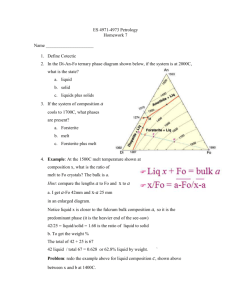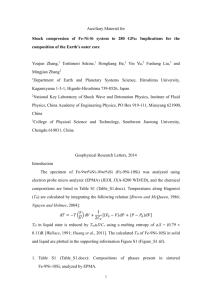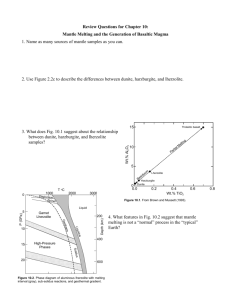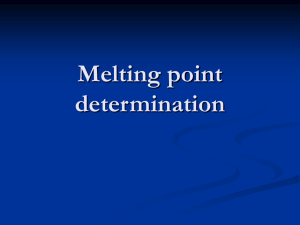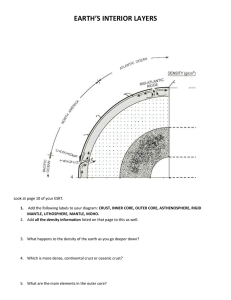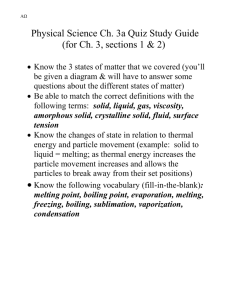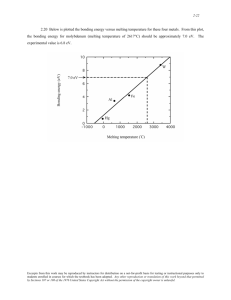Slide 1
advertisement
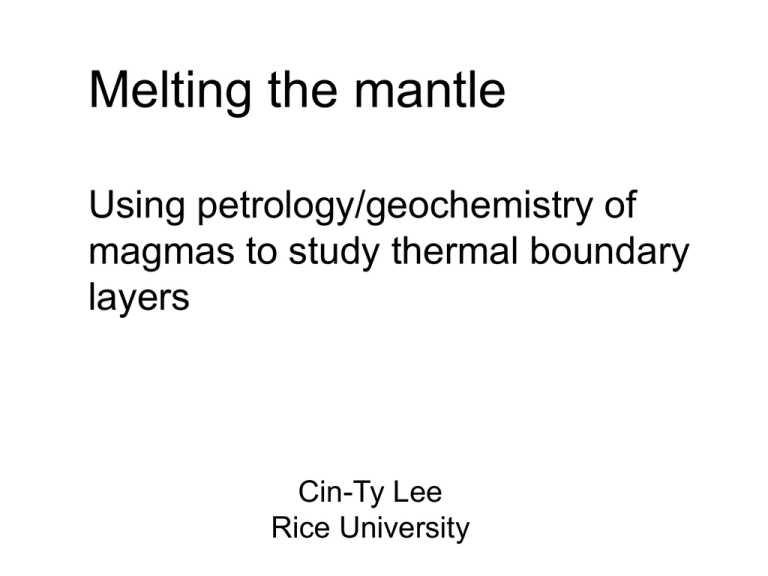
Melting the mantle Using petrology/geochemistry of magmas to study thermal boundary layers Cin-Ty Lee Rice University How melting happens Temp ( oC) 500 0 1000 1500 2000 Decompression melting 5 200 10 300 Depth (km) P (GPa) 100 Depression of solidus Isobaric heating Temperature (K) 1000 0 2000 3000 4000 Thermal boundary layer Upper mantle 410 14 Transition zone 670 Depth (km) Pressure (Gpa) 24 Lower Mantle ULVZ? 3000 138 Ocean Plume Midocean Ridge Continental Crust Base of lithosphere Melting occurs near boundary layers Melts advect heat Melts lead to chemical differentiation Mantle Core We are interested in determining the T, P, and F of melts T Thermal state of the mantle Thickness of continental lithosphere P The presence of volatiles 1.What is melting 2.Decompression Melting 3.Hydrous melting 4. Constraining the thermal state of the mantle (observables) 1. What is melting? Solid = long-range (crystalline) order Liquid = short-range order characterized by molecular clusters having local ordered structure H2 O UNARY SYSTEM - Constant P solid Liq Solid + Liq Melt fraction F Cumulative Heat added into system H mcp T dH H fus t fusion dt (or taken out of the environment) T solidus time liquidus H mcp T Temperature is buffered at the phase change because the heat being added is involved in making a phase change: HEAT OF FUSION If a phase change is not occurring, heat goes directly into causing the atoms to vibrate more, resulting in an increase in temperature In both cases, entropy increases dq dS T Entropy change associated with melting is: S H f Tf T dq dT S mc mc ln p Entropy change associated with heating is: T p T To solid solid+ Liq Melt fraction F Entropy of system T S mcp To S T time H f Tf Liq Same concepts hold in multi-component systems 1600 1 atm = 0.1 MPa Temperature (oC) 1500 LIQUID 1400 T3 L3 L2 L1 T2 1300 x3 S3 X-specific liquidus x2 S2 x1 T1 S1 S1 solidus Eutectic 1200 1100 Diopside CaMgSi2O6 Anorthite + Diopside X0 X (Wt. %) Anorthite CaAl2Si2O8 2. Decompression melting Mid-ocean Ridge T P Decompression melting Stolper & Asimow 2007 What controls the slope of the solidus in P-T space? Clapeyron slope S f dP dT 2 V f S f 0 V f 0 dP 0 dT 2 Presnall et al. (1978). Contr. Min. Pet., 66, 203-220. Isentropic decompression (“adiabatic” decompression) •Assume buoyancy-driven advection rates >> thermal diffusion no heat loss q=0 •Assume process is reversible, dS = 0 dE = dq + dw = TdS – pdV = -pdV Cp dP dT s TV Solid isentrope (“adiabat”) Temperature drops slightly during decompression because system expands and does work on the environment, decreasing internal energy (hence T) CAUTION: there are many adiabatic processes that are not isentropic Melting the mantle Potential temperature TP V Tp (0) T ( P) exp P CP g Tp (0) T ( z ) exp cP z Let’s look at constant entropy processes dE dq dW dq PdV H E PV dH dq VdP dq TdS dH TdS VdP H ( S , P) H H dH dS dP S P P S H T S P H V P S For simplicity, let’s assume a one-component mantle Constant P Constant P (S2, H2) T H S P pe H (S1, H1) 1 H slo A S B A+B S Stolper & Asimow 2007 Stolper & Asimow 2007 Unary system, melting solidus and liquidus coincide melting is constrained to the solidus/liquidus Partial melting occurs Stolper & Asimow 2007 And now back to a multi-component mantle liquidus does not coincide with solidus partial melting occurs across the interval btwn solidus and liquidus Melting isentrope is steeper than that of solid isentrope because energy is being absorbed to cause a phase change 3. Multicomponent melting Example - Hydrous melting Temp (oC) 500 0 1000 1500 2000 5 200 10 300 Depth (km) P (GPa) 100 Ex: Water dissolves in liquid T,P GT , P X i i GT , P i io RT ln X i GT , P X i io RT X i ln X i S R X i ln X i Xi Molar Gibbs Free Energy Freezing point depression Freezing point depression Tmelting Tmelting temperature Why does wet solidus curve back to dry solidus at low P At low P, solubility of water in melt is very small, so no significant increase of melt entropy when water is added to the system Berndt et al. 2005 4. Constrain the physical conditions of melting F = melt fraction T = temperature P = pressure T Thermal state of the mantle High F = High T P Solid residue 1-F Original solid = o sol C M o sol + Melt F Csol M sol Cmelt M melt F = Mmelt/Mosol CONSTRAINING F (melt fraction) Trace elements as a tool melt Partition coefficient Csolid D= Cmelt Cmelt 1 o Csol DB F (1 DB ) Solid residue D>1 compatible in solid D<1 incompatible in solid Equilibrium Melting 100 Melts Cmelt/Co 10 D<1 incompatible D=0.01 0.1 0.5 1 1 D>1 compatible 5 10 0.1 0 0.2 0.4 0.6 0.8 1 F When D = 0 (perfectly incompatible element) (e.g., Na, Cs, Nb, Ba) C melt o C sol 1 ~ F Primitive magma MORBs Klein and Langmuir 1987 F increases Cmelt /Co ~ 1/F Increasing F Regionally averaged MORB compositions plotted against axial depth of ridge Klein and Langmuir 1987 Does crustal thickness vary with axial depth? Forsyth, 1992 Temperature and Pressure thermobarometry Thermometers Mg2SiO4 (olivine) + Fe2SiO4 (melt) = Mg2SiO4 (melt) + Fe2SiO4 (olivine) Mg2SiO4 (olivine) = Mg2SiO4 (melt) S f dP dT 2 V f Fe / Mg ol Fe / Mg melt small P 1900 1 atm = 0.1 MPa 1800 Temperature (oC) K Fe / Mg D T 1700 “forbidden zone” 1600 T3 1500 1400 LIQUID T2 T1 S3 L3 X3 S2 X2 S1 L2 X1 L1 1300 OLIVINE 1200 1100 Mg2SiO4 X0 Wt. % Fayalite Fe2SiO4 Roeder-type 45Plot of Magma Compositions Using Putirka calibrations 0.93 0.92 0.91 0.90 0.89 40 Fo=0.88 35 1700 30 1600 25 mole % Mg 1500 20 1400 15 1300 10 1200 C 5 0 0 5 10 mole % Fe 15 20 Barometers Mg2SiO4(olivine) + SiO2(melt) = Mg2Si2O6(pyroxene) K (T , P) ~ K~ px a Mg 2 Si 2 O 6 ol melt a Mg 2 SiO4 a SiO2 large S f dP dT 2 V f 1 a melt SiO 2 1 atm = 0.1 MPa 1700 T1 Liquid + Forsterite T B LIQUID L + Si-poly 1600 T (oC) P Pe TPe TE L + En E 1500 Enstatite + Si-polymorph Forsterite + Enstatite Xo 1400 Forsterite Mg2SiO4 X1 Enstatite MgSiO3 SiO2 Wt. % 65 1 0.9 55 0.8 0.7 0.6 0.5 0.4 0.3 50 45 40 35 30 25 0.2 A 0.1 B 20 1000 oC 15 0 35 40 45 50 55 60 65 0 1 2 3 4 5 6 7 P (GPa) SiO2 (wt. %) 5.0 0.30 C D this study Haase Albarede 3.0 0.20 (TCalc-Texp)/Texp 4.0 PCalc - PExp Mol % Si4O8 anhydrous Mol % Si4O8 (hydrous) Wt % SiO2 (anhydrous) Wt % SiO2 (hydrous) Experimental Melts 60 % silica index Mg# = Mg/(Mg+Fe) Anhydrous Hydrous Experimental Melts 2.0 1.0 0.0 -1.0 -2.0 -3.0 0.10 0.00 -0.10 -0.20 -4.0 This study Putirka A (2005) Putirka C (2005) Sugawara (2000) -0.30 -5.0 0 1 2 3 4 5 6 Experimental P (GPa) 7 8 1000 1200 1400 1600 Experimental T (oC) 1800 8 Classification of magma compositions – not just random classification! 16 15 14 phonolite 13 Nephelinite 12 Tephri-phonolite trachyte K2O + Na2O 11 rhyolite 10 Phono-tephrite 9 trachyandesite Hi P 8 7 Basaltic trachy-andesite Tephrite or basanite 6 Trachy-basalt 5 4 3 Basalt 2 Basaltic andesite Lo PAndesite Dacite Picrobasalt 1 0 40 45 50 55 60 SiO2 65 70 75 How hot is the mantle? 7.0 1600 1700 0 20 40 Spinel/garnet transition 60 80 100 120 140 160 180 200 220 P (GPa) 1500 1200 1300 1400 0.0 20 30 0.5 F=10 1.0 1.5 2.0 2.5 . 3.0 3.5 LAB plate 4.0 4.5 5.0 Hawaiian Hotspot 5.5 Post-shield 6.0 Shield stage 6.5 7.0 1500 1600 1700 0 TP 20 40 LABeroded 60 80 100 120 140 160 180 200 220 Depth (km) 1200 1300 1400 0.0 TP 0.5 1.0 1.5 2.0 2.5 . 3.0 3.5 4.0 4.5 Mid-ocean ridge 5.0 basalts 5.5 East Pacific Rise 6.0 Mid-Atlantic Ridge 6.5 T (oC) Depth (km) P (GPa) T (oC) CONTINENTAL LITHOSPHERE T (oC) western Basin and Range Basin and Range A’ A Colorado Plateau 1200 1300 1400 1500 0.0 TP 0.5 1.0 1.5 2.0 LABBR 2.5 3.0 LABCP 3.5 4.0 4.5 5.0 5.5 Western North 6.0 America 6.5 7.0 1600 1700 0 20 40 60 80 100 120 140 160 180 200 220 Depth (km) <1 Ma (Coso, CA) Plateau Colorado <1 Ma (Amboy, <1 CA) Ma (San Francisco, AZ) <1 Ma (Pisgah, CA) Snake River Snake Plain River Plain P (GPa) Rio Grande Rift Cenozoic western <1 MaNorth (Big Pine, CA) <1 America Ma (Zuni Bandera, NM) ARCS T (oC) 1100 1200 F=10% 1300 20% 1400 1500 0 30% 0.5 Moho P (GPa) 60 2.0 80 2.5 Depth to slab 3.0 Fo 90 anhydrous Fo 90 3 % H2O Fo 90 7 % H2O 4.0 100 120 1100 1200 F=10% 1300 30% 1500 0 20 Moho 1.0 40 1.5 60 2.0 80 2.5 3.0 3.5 Anhydrous (Fo90) Hydrous (7 wt. % H2O) Fo90 residue hydrous Fo92 residue hydrous 4.0 Cascades Arc 1400 Izu-Bonin Arc 100 120 Depth (km) . Depth (km) 40 1.5 1000 0.0 0.5 20 1.0 3.5 B P (GPa) A 1000 0.0 T (oC) T (oC) T (oC) 1600 1700 0 100 1.0 200 1.5 300 2.0 400 2.5 500 3.0 3.5 4.0 4.5 600 MOON 700 Apollo 17 Apollo 14B 800 900 5.0 B 1100 1200 -0.5 1300 1400 1500 1600 1700 D 1.0 1.5 2.0 Cumulate Eucrites B-EUCRITES Eucrites (Warren) NWA 011 (Yamaguchi et al.) P (GPa) P (GPa) 0.5 1400 1500 1100 1200 1300 0.0 0.5 1.0 1.5 2.0 2.5 3.0 3.5 4.0 4.5 5.0 5.5 Venera 13 6.0 Venera 14 6.5 Vega 2 7.0 1400 1500 1600 1700 0 100 200 300 400 MARS 500 1600 1700 0 50 100 150 VENUS 200 Venusian Depth (km) 0.0 1100 1200 1300 0.0 0.5 1.0 1.5 2.0 2.5 3.0 3.5 4.0 4.5 5.0 5.5 6.0 Gusev crater 6.5 Yamato 7.0 Martian Depth (km) 0.5 C P (GPa) 1300 1400 1500 Lunar Depth (km) P (GPa) A 1100 1200 0.0 Komatiites – deep melting T (oC) 1200 1300 1400 1500 1600 1700 0.0 1800 1900 0 TP 0.5 TP 20 1.0 40 1.5 60 2.0 P (GPa) Hawaii 80 . 3.0 100 3.5 120 4.0 140 4.5 5.0 5.5 6.0 6.5 7.0 Komatiites Carribean-Colombia-Gorgona Kaapvaal, South Africa west Australia Superior Prov., Canada 160 180 200 220 Depth (km) 2.5 At high pressure, dP/dT becomes very large S f dP dT 2 V f S f 0 V f 0 Stolper & Asimow 2007 Deep Melting? Could deep melts have been negatively buoyant? Could they have generated an enriched and Fe-rich lower mantle? S f dP 0 dT 2 V f S f 0 V f 0 Miller et al. 1991 ? Nature of thermal boundary layers can be assessed by the geochemistry and petrology of magmas Temp ( oC) 500 0 1000 1500 2000 5 200 10 300 Depth (km) P (GPa) 100 Berndt, J., J. Koepke, et al. (2005). "An experimental investigation of the influence of water and oxygen fugacity on differentiation of MORB at 200 MPa." J. Petrol. 46: 135167. Courtier, A. M., M. G. Jackson, et al. (2007). "Correlation of seismic and petrologic thermometers suggests deep thermal anomalies beneath hotspots." Earth Planet. Sci. Lett. 264: 308-316. Grove, T. L. and S. W. Parman (2004). "Thermal evolution of the Earth as recorded by komatiites." Earth Planet. Sci. Lett. 219: 173-187. Klein, E. M. and C. H. Langmuir (1987). "Global correlations of ocean ridge basalt chemistry with axial depth and crustal thickness." Journal of Geophysical Research 92(B8): 8089-8115. Langmuir, C., E. M. Klein, et al., Eds. (1992). Petrological systematics of mid-ocean ridge basalts: constraints on melt generation beneath ocean ridges. Geophys. Monograph, American Geophysical Union. Miller, G. H., E. M. Stolper, et al. (1991). "The equation of state of a molten komatiite 2. Application to komatiite petrogenesis and the Hadean mantle." J. Geophys. Res. 96: 11849-11864. Putirka, K. D., M. Perfit, et al. (2007). "Ambient and excess mantle temperatures, olivine thermometry, and active vs. passive upwelling." Chem. Geol. 241: 177-206. Stolper, E., D. Walker, et al. (1981). "Melt segregation from partially molten source regions: the importance of melt density and source region size." J. Geophys. Res. 86: 6261-6271.
